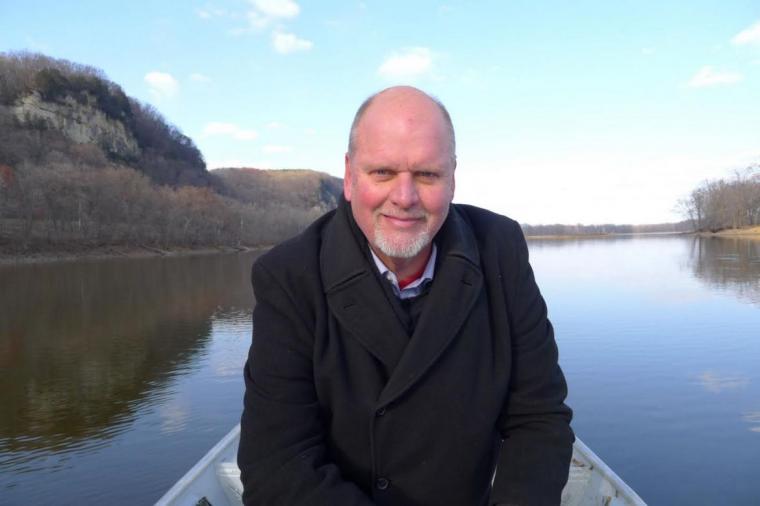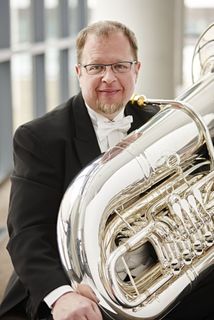
The Mississippi River brings to mind images of steamboat travel, devastating floods, and Huckleberry Finn on his raft.
The tuba conjures visuals of marching bands, Oktoberfests, and the mother ship making contact at the end of Close Encounters. (Okay, that last one might just be me.)
Audience members for the Quad City Symphony Orchestra’s season-opening Masterworks concerts, however, might find that, from now on, whenever they think of either the Ole Miss or the tuba, they’ll immediately also think of the other.
Best-known for pop-culture-themed works such as Jackie O, Dead Elvis, and the comic-book-inspired Metropolis Symphony, Grammy-winning composer Michael Daugherty went back to his Iowa roots for 2013’s Reflections on the Mississippi, a concerto that will be performed by the symphony on October 1 (at the Adler Theatre) and October 2 (at Augustana College’s Centennial Hall).
Beyond being a celebration of a river Daugherty admires, Reflections on the Mississippi is a celebration of an instrument Daugherty admires, as the composition is also the rare 20-minute showcase for a tuba soloist – a role assumed locally by visiting Minnesota Orchestra musician Steven Campbell, whose professional credits include performances with the Philadelphia and Boston Pops orchestras and the Orquesta Sinfónica de Galicia in Spain.
In separate phone interviews, Daugherty and Campbell spoke about Reflections on the Mississippi and the river it’s inspired by, and also shared some thoughts on the tuba’s place in both the concerto and the public imagination.

A World to Step Into
“I’m the kind of composer who really has to have an idea of what the piece is going to be about emotionally,” says Daugherty. “And it needs to have a sort of narrative. For me, it’s about more than just writing notes. There has to be a reason I’m writing the piece.”
With tongue most likely in cheek, he adds that in the case of Reflections on the Mississippi, “I guess one reason could be, ‘Well, you have a commission to write a tuba concerto,’” as the work was initiated by Temple University’s Boyer College of Music & Dance. “But I need more than that. I need much more than that. I need to have a script. I need to have a title. I need a sort of world arranged in my head that I can step into.”
Or, for this particular creation, step back into.
“I wanted to write a piece inspired by my times when I was young,” says the Cedar Rapids native, “when my family came up to McGregor, Iowa’s Pike’s Peak State Park along the Mississippi. I had fond memories of those trips, and my father passed away recently [in 2011], so I sort of wanted to dedicate something to his memory.
“But I also knew I was going to write a work for tuba in an orchestra,” Daugherty continues, “and the tuba’s kind of a mournful, bigger-than-life instrument. It could almost be a foghorn in a way. So it seemed like an instrument that fit with the theme of the Mississippi River.”
Before he composed a single note for Reflections on the Mississippi, Daugherty – who serves as professor of composition at the University of Michigan – sought inspiration through two return treks to Iowa in the summer and fall of 2012.
According to the concerto’s program notes (available at MichaelDaugherty.net), the composer’s road trips from McGregor to Hannibal, Missouri were spent “collecting sounds, musical ideas, and an emotional framework for my tuba concerto.” Yet Daugherty admits that explaining exactly how that was done, or what that entailed, is tricky if not impossible.
“It’s kind of a mysterious process,” says Daugherty, “and I think that’s one of the reasons it’s intriguing, because it’s very hard to put into words. For example, one of the things I did was I caught two amazing sunsets – one of them from Pike’s Peak State Park, which has really great vistas. I was by myself, and I felt this sense of timelessness, and certain melodies and tunes would just come to mind as I was standing there.
“But there’s a mystery there – that mystery of how an idea is translated into music. And I think the fact that we really don’t know for sure how it’s done, and that it’s hard to articulate, draws us to it. Because it’s magical.”
One of Reflections on the Mississippi’s magical qualities is the way it suggests an actual north-to-south voyage down the Mighty Miss, beginning in the tranquil waters of Minnesota and culminating in the spirited environs of New Orleans over four movements titled “Mist,” “Fury,” “Prayer,” and “Steamboat.”
“I never know exactly how the piece is going to lay out as far as the individual movements,” he says. “It’s kind of like the way a film is shot. You have a script, and then you shoot the film many times but not necessarily in [chronological] order ... . And sometimes the script isn’t even finished and you’re still shooting.
“In this particular case, I wrote the first movement first. I knew I wanted to start with something slow, a kind of hazy feeling, and then transition into something fast, which is where the sound and the fury of the second movement comes in – something more agitated and rhythmically driving. Then I wanted to return to something more laid-back, something more reflective, which is how the third movement came to be. And I knew I wanted to end up down in Louisiana, where the tuba is so prominent in New Orleans music.
“It’s what I usually do: I write a movement, and then I react to that movement and try to do something different. And then after I’ve written those two movements, then I react to those two movements ... . It’s kind of a building-block process, reacting to what’s previously been constructed.”
Although he didn’t have the concerto’s four movements in mind from the start, Daugherty did know that he wanted Reflections on the Mississippi to be a true orchestral showcase for its principal instrument.
“The first thing I wanted to do was something that was unexpected,” he says, “and that was the tuba playing melodies high in the register of the instrument. I listened to pretty much every tuba concerto written in the 20th Century, and what struck me was how few of them had the tuba playing in the high register and playing long lines or melodies.
“Frequently, the tuba is introduced as a humorous instrument. An instrument for polka music or something – i.e., it’s not taken that seriously. And what I wanted to do right away was totally disarm that notion. Tuba players long ago ... didn’t have the greatest technique. But tuba players now have fantastic technique. So that’s what I wanted to do in the ‘Mist’ movement – write a very gorgeous kind of melody for tuba that you don’t expect.
“And then, as a reaction to that in the second movement, I wanted to show how the tuba can be almost like an electric bass in a rock band.”
Inspired by the Great Mississippi Flood of 1927 and the turmoil of the river as captured by novelist William Faulkner, “Fury” was conceived as a way to demonstrate that the instrument “could be very driving, and very rhythmically exciting. It doesn’t have to be this lethargic sound, the way many people think of the tuba. It can be very rhythmically nimble.”
For Reflections on the Mississippi’s “Prayer,” Daugherty says, “I wanted to have the tuba being very dramatic and soulful.” With the instrument evoking both the river’s power and the calm after a storm, the third movement “is an original tune, but I wanted it to suggest a great river tune of the past, and the music was spun out to be very majestic. To show the tuba as a very majestic instrument.”
Finally, Daugherty’s “Steamboat” was fashioned to suggest Mark Twain’s Life on the Mississippi, filled with lively melodies and rhythms, and with, as the composer says, “the tuba used as a jazzy, exciting street instrument.
“The Mississippi travels down a particularly interesting list of cities, cutting right through the center of the country, and writers and poets and musicians have really been drawn to it. It brings a lot to the imagination. And ending down in New Orleans, we’re able to end [Reflections on the Mississippi] on an exciting note for the tuba. It really, really captures a lot of sides to that instrument that many people probably don’t know about. Except, maybe, other tuba players.”

More Than Oompah
For Steven Campbell, playing the tuba is more than his professional career. It’s practically the family business.
“My dad’s a retired college band director, but he still plays the tuba,” says Campbell. “He plays in a community orchestra near my hometown in Brenham, Texas, and from a young age I knew I wanted to play tuba like him. So he taught me some scales on the euphonium at about age nine or 10, and then I started on the tuba in band in sixth grade.
“I’ve just always loved the deep sound and its role in band or orchestra. Being the foundation for whatever orchestration is happening, whether ... with me and the strings, or me and the winds, or obviously with the brass section – being able to give them a nice cushion to sit on. I enjoy that. And of course, if I didn’t love playing long notes, I probably wouldn’t be playing the tuba.”
As the young Campbell quickly discovered, though, the tuba does come with its challenges. “It’s a pretty large instrument, and I had a pretty late growth spurt,” he says with a laugh. “I mean, they have student-model sizes for little kids. But still, the mouthpiece is the same size no matter what, so if it goes over your nose, you really can’t play.”
The instrument’s challenges, however, don’t end even if you’re an adult professional whose mouthpiece fits perfectly.
“The biggest challenge is air – getting enough air to blow through the thing,” says Campbell. “You have to do a lot of breathing exercises, and I’ve found that swimming really helps. ...
“But you also have to be very accurate,” he continues. “Being related to the French horn, the tuba is a conical instrument, and when you play in the upper register, the notes get closer and closer together; you have to know exactly where you’re going to buzz into the mouthpiece to get the right note. It’s like throwing darts: You’ve got to get it right there.
“That’s why it’s challenging, and fun, playing a solo like the Daugherty. It doesn’t hang out in the extreme high register all the time, but when it goes up there, you really have to be able to play with confidence.”
Discussing Reflections on the Mississippi’s four segments, Campbell says, “The first and third movements, ‘Mist’ and ‘Prayer,’ are the slower, softer ones, and there’s really beautiful writing in them; they show how the tuba can be such a beautiful melodic instrument. So I’m trying to just let the melodies float, or soar, over the orchestra.
“The second and fourth movements, ‘Fury’ and ‘Steamboat,’ are much more active. There’s a lot of crisp articulation in ‘Fury,’ and I’m really trying to create the sound of, like, the river flooding, or a violent storm on the Mississippi. And ‘Steamboat’ has a bit more of a ‘traveling down the Mississippi’ feeling, and some jazz influences as you get down to New Orleans.
“So the challenge,” says Campbell, “is in trying to play with a rich, beautiful, projecting sound while not changing the color between the aggressive notes and that more lyrical, wispy type of sound. Because the movements, I think, complement each other quite well.
“And it’s fun to be able to draw inspiration from what Michael Daugherty was thinking, and what he writes in his notes for the score. I mean, everyone’s going to picture whatever’s going on in their own minds as they listen, but if you have something in your mind when you play, the audience can pick up on what that is.”
As a musician “whose job is primarily to sit in the back row of the orchestra,” Campbell adds that he’s especially pleased for the chance to showcase the tuba as a solo instrument in Reflections on the Mississippi, an opportunity that doesn’t often arise. (Unlike the majority of orchestral instruments, the tuba arrived relatively late to the party, having been patented in 1835.)
“Just last summer,” he says, “I performed Ralph Vaughan Williams’ Tuba Concerto, which is counted as the first tuba concerto, and it was written in 1954. It’s a fantastic piece, and we’re lucky to have our first concerto written by such a notable composer, but still, that’s not really that long ago – only 62 years.
“Since then, there’s been a fair amount of repertoire: solo tuba and piano, solo tuba by itself. And with it being relatively modern, there’s a lot of music that’s very contemporary – music for tuba and synthesized recordings and so forth.
“But,” says Campbell with a laugh, “we sometimes do have to thieve a little bit from other instruments. If you want to play, for example, any Bach, you steal from the cello line, because the tuba just wasn’t around back then. That’s why I definitely like to promote new music being written for the tuba, because although it has an ever-growing repertoire, it’s not necessarily known as a solo instrument.
“A lot of people immediately think of the tuba,” he continues, “and think marching band, the sousaphone, and ‘oompah.’ Or just big fat low notes. And of course, that is a big part of what the tuba is. A lot of times, it’s my job to be part of the rhythm section almost like a fourth trombone in the orchestra, and just provide a little bit of a deeper sound to fill out the section.
“But there are quite a few pieces where even if it’s just a 10-measure line, it’s definitely the tuba you’re hearing, and you get to be a soloist. You have to know just how to come out of the texture and when to go back in. That’s why you look forward to works like the Daugherty. You get the chance to have an exposed solo in an orchestra and people are like, ‘Wow – I didn’t know the tuba could do that!’”
The Quad City Symphony Orchestra’s Masterworks I: Heroic Mississippi repertoire will also feature Strauss’ Don Juan Op. 20 and Beethoven’s Symphony No. 3 (Eroica). Performances will be held at the Adler Theatre (136 East Third Street, Davenport) at 8 p.m. on October 1, and at Augustana College’s Centennial Hall (3703 Seventh Avenue, Rock Island) at 2 p.m. on October 2.
For more information and tickets, visit QCSO.org.








